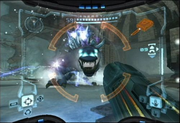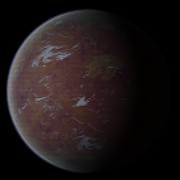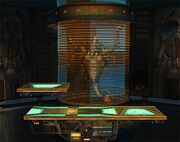Metroid Prime is a first-person adventure/shooter video game developed by Nintendo-owned Retro Studios and released by Nintendo in 2002 for the GameCube. It was the first 3D Metroid game and is officially classified by Nintendo as a first-person adventure rather than a first-person shooter due to the large exploration elements in the game. It was either released directly before or after the Game Boy Advance video game Metroid Fusion (the former for America and the latter for Japan, Europe, and every other market that got the game). For America, it was the first game in the series since Super Metroid on the SNES, which was released all the way back to 1994.
Like all games in the series, Metroid Prime stars intergalactic bounty hunter Samus Aran. Other familiar faces such as Ridley, the Space Pirates and the Metroid also appear. The game is the first of a three part video game series that also include Metroid Prime 2: Echoes and Metroid Prime 3: Corruption for the GameCube and Wii, respectively.
The game was highly acclaimed by most critics and received multiple game of the year awards from, and not exactly limited to GameSpot, Gamespy, EGM, Nintendo Power and Edge. It received the runner up award from IGN, though did get the best of the GameCube for 2002.
In October of 2008 Nintendo announced that Metroid Prime, its sequel and various other GameCube games would be remade for the Wii console as part of the Enjoy with Wii series. The game will include enhanced motion controls thanks to the Wii Remote.
Gameplay
A traditional Metroid game basically is a sidescrolling sci-fi shooter. The games never strayed too far off, until Prime came along. The newly found developers meant to create a Metroid game rather than just another first person shooter, and fans and critics alike agree that they successfully accomplished this most challenging goal. While some of the elements are distinct and unfamiliar to the series, it certainly seems to have that special Metroid "essence" that makes the series so special.
The game has abandoned the sidescrolling perspective and is a full-fledged 3D adventure game. Staying true to the series, the game takes place in a large, free-roaming world, and includes plenty of diversions and out-of-the-way areas.
The huge world (Tallon IV) in which the game takes place is connected via elevators that take you to the multiple different sections, each one being dramatically different from one another. Like the Metroid video games preceding it, each area has a multitude of rooms each banded together and separated by doors that can be opened simply by shooting them.

The shooting aspect has also been immensely improved. To make the gameplay a tad more accessible, the developers have incorporated a unique lock-on system which allows the player to track enemies and certain objects simply by pressing the R button. For those who want to aim less readily, then that person is capable of pressing the L button which will allow him or her to point more directly at an un-lockable object.
A popular ability of the protagonist Samus Aran is being able to transform into a Morph Ball, which reduces her to the size (arguably) of a bowling ball, allowing her to access areas that were previously impassable. In this form she's also able to lay morph ball bombs, which will explode within a second or two after planting them. With these bombs, she is capable to damage potential enemies and launch herself upwards, making her perform a sort of jump. In this form, the player will look through a third-person perspective rather than a first as you normally do.
Among other abilities and weapons include ones that she'll have to obtain over time. The missiles are among the most popular, and the most potent and available weapons in the game. Her suit will also go through imporvements as well; for example, the Varia Suit will allow her to walk through scorching areas, though will not make her immune to intense lava and fire.
One of the most popular and new features in the game is the scan system. With this, Samus Aran is capable of learning the history and abilities of the world and the creatures surrounding her. Almost everything that moves is scanable, giving the player a grand backstory and a more improved plot if they wish for it.
Plot
The developers have included a constructive and extensive story that help develops the story of Samus Aran and the many different themes, species, and antagonists of the series, along with giving new worlds to explore and learn about. If the player wishes, he or she is given the chance to learn more about every aspect of the plot by scanning the copious objects in the game.
In the beginning, Samus Aran will land on the Frigate Orpheon, responding to a distress call she received. Once she is ejected from her ship, she explores the inside where she finds that the entire crew has been ambushed by a mutated parasite that became corrupted through the Space Pirate's experiments with Phazon, a dangerous and powerful substance that is destroyed in the final installment of the series, Metroid Prime 3: Corruption for the Wii.
After fighting and ultimately killing the mutated beast, who's name is the Parasite Queen, the boss falls into the ship's reactor, thus making it explode within a few minutes. Samus escapes, though she looses all of her weapons through an electrical surge that resulted in the destruction. This is when she spots Ridley, who flies off to Tallon IV. Samus makes an appropriate decision and follows him onto the planet.
Once landed on the planet, Samus was required to find Chozo Artifacts in order to enter the Chozo Temple, which at the time the Space Pirates were attempting to break through. She then goes through three primary areas and inflitrates each of the Space Pirate's bases. While exploring the Phendrana Drifts, she comes across the first Metroids in the game in a Space Pirate lab.
After entering the Chozo Temple, she comes across the final boss of the game - Metroid Prime. Here she destroys the beast, though the concluding scene shows it still being alive, where it possesses Samus' Phazon Suit. Samus manages to escape, but the next game would focus more on what the beast turned into; Dark Samus.
Setting

The game mostly takes place on the planet known as Tallon IV, which features a diverse environment that consists of scorching undergound segments, icy tundras, eery forests, Phazon mines and desert ruins. The first portion of the game takes place on a ship that got ambushed, though it can basically be considered a training stage. Niether of the sequels take place on Tallon IV, excluding the remake Metroid Prime Pinball.
The actual atmopshere can sustain human life, among other life forms. There is a healthy amount of oxygen and plenty of vegetation and meat for their respective consumers.
Characters
- Samus Aran - Samus is the female protagonist who has appeared as the playable character in every Metroid video game to date. She's noted as the first playable human female in video games.
- Ridley - The Antagonist of the video games and arguably the primary antagonist of this video game (along with Metroid Prime).
- Metroid Prime - Another antagonist of the video game, Metroid Prime is a mutated beast that was the result of a mixture with Phazon. Samus defeated it in the end of the game, though it fused with a stolen Phazon Suit and results in Dark Samus.
Development
Metroid was the only of Nintendo's major franchises that didn't have an appearance on the Nintendo 64. The only title that would even mildly constitute as one would be Samus' playable appearance in Super Smash Bros. To satisfy the desires of fans for a new Metroid, Nintendo assigned the task to new found Retro Studios.
Nintendo initially planned to release a Metroid game fro the Nintendo 64, though according to Mario and Zelda creator Shigeru Miyamoto, the team in Japan couldn't develop any outstanding ideas, so fans would have to wait for the next generation of consoles.
The Texan game developer Retro Studios opened its doors in 1999 and already had plans to develop the new Metroid title for the GameCube despite not having development kits. Plans were made to make Metroid Prime a third person shooter, though according to Retro, Miyamoto scrapped all of their ideas and turned the game into a first person shooter, arguably for the better. This was due to the fact that often times it can be hard to shoot in the third person. According to Miyamoto, he wanted to create a third person video game long before the release of Prime; in an interview with Nintendo president Satoru Iwata regarding Link's Crossbow Training for Wii, Miyamoto stated that he originally wanted The Legend of Zelda: Ocarina of Time to be third person, though they eventually decided not to go this route.
After awhile, Nintendo ended up putting a halt to three of Retro's games so that they could focus exclusively on Prime and another one of their titles, Raven Blade. Ultimately, the former title was also canned so that they could put their full devotion to Prime.
From the beginning the president of Retro, Michael Kelbaugh, stated that the team wanted to create a Metroid first person shooter rather than just another regular first person shooter with Metroid afterthoughts. They obviously succeeded in this. According to him, one of the hardest aspects to include in the game was the transition and translation into the Morph Ball form, and apparently how it controls.
The music in the video game was created by Kenji Yamamoto and Kouichi Kyuma, and included original songs, albeit some remixes of songs from previous Metroid games. A soundtrack of the game was released that featured music from both Prime and Fusion.
Legacy

Super Smash Bros. Brawl.
The game has spawned three seqeuls and a remake - Metroid Prime 2: Echoes, Metroid Prime 3: Corruption, Metroid Prime Hunters, and Metroid Prime Pinball, with the latter game being considered the remake of the video game. The first two mentioned games further the story more constructively than Hunters does, which has been considered a spin-off of the series by most.
The Frigate Orpheon is a stage in Super Smash Bros. Brawl for the Wii, and to go along with it the Parasite Queen is stationed in the background the entire time. Characters, elements, stickers and trophies can be found throughout the entire video game.
Reception
The critics appreciation for the game was astronomical. From the cream of the crop, the game received no negative reviews, and the game came in possession of a copious amount of "game of the year" awards from a multitude of different websites and magazines such as Gamespot, Gamespy, Nintendo Power, EGM, Edge and others. EGM and Nintendo Power alone gave it perfect scores (an outstanding feat from EGM which has three reviewers review the game).
Other awards include the game of the year from the 2003 Game Developers Conference and the excellence in level design, and the "console first-person action" game of the year from the 6th Interactive Achievement Awards.
Currently, it is one of the better selling GameCube titles, selling 1.49 million copies in the US alone. It didn't fare as well in other countries, though did have minimal success in Europe and Japan (In America and Europe the game eventually became a Player's Choice title).
Trivia
- Metroid Prime is ranked as the seventh highest rated game ever at GameRankings.
- Kraid from the sidescrolling series was supposed to be in the game, and was even designed by Retro's Gene Kohler, though because of time they decided not to include the famous boss in the game.
| Metroid series | |
|---|---|
| Metroid series | Metroid (NES Classics) • II: Return of Samus • Super Metroid • Fusion • Zero Mission Other M • Samus Returns • Dread |
| Metroid Prime series | Metroid Prime (New Play Control! • Remastered) • 2: Echoes (New Play Control!) • Prime Hunters • Prime 3: Corruption • Prime 4 Prime Pinball • Prime: Trilogy • Federation Force |
| Related | Nintendo • Retro Studios • Samus Aran • Super Smash Bros. • Nintendo Land Gunpei Yokoi • Kensuke Tanabe • Yoshio Sakamoto |
